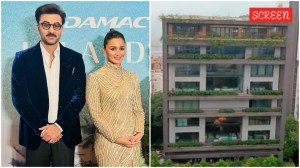The queen of angst lives on
Reams of shimmering silk offer a glimpse of twin pools of profound grief. Eyelashes flutter and the exquisite form sways in intoxication. Wh...

Reams of shimmering silk offer a glimpse of twin pools of profound grief. Eyelashes flutter and the exquisite form sways in intoxication. Whether she is the gorgeous courtesan wronged by society in Pakeeza or a feudal lord’s wife driven to alcoholism in Sahib Bibi Aur Ghulam, the late Meena Kumari has taken pain, loneliness and self-destruction to an art form. In real life, however, these qualities are unpleasant. And they nag and irritate like a newly-healing wound. While re-constructing her identity and image in popular Hindi cinema, A Box of Shards/The Mermaids Mirror — a multi-media presentation — tries to blend the ethereal with the actual.
Also titled Memories of Meena Kumari Naaz, this installation by Sheba Chhachhi is also accompanied by a dance performance Becoming Meena’ by Navtej Singh Johar. The programme is being organised by the Jindal Arts Creative Interaction Centre (JACIC) of the NCPA in collaboration with Eicher Gallery, New Delhi.
The installation tells no story, nor is it a mere exhibition of the actress’ posters. It can be best described as a compilation of images, sound and even tangible objects that denote the immense power of tragedy that she signified. As you enter the room, there is a wall covered with Meena Kumari’s film posters. The familiar images of wife, mother and courtesan are repeated in colour. As you proceed, the colour pictures streamline into dark blue monochrome.
Then begins the journey along a river of broken glass strewn on the floor. Bits of Meena Kumari’s poetry in Urdu and Hindi are inscribed on some of these shards — words casually thrown about and trampled on. Meena Kumari’s various names — Baby Meena, Mehnaz, Mehzabeen… are also written on glass. The river then opens out into a circle of vertically-placed mirrors. These mirrors reflect sword-like images which are fragile and lethal at the same time.
Further along the journey, the mirrors grow nearly eight feet tall. In this play of reflection, you see parts of the tragedy queen along with parts of yourself thus, merging the apparition that was and the real person you are. Guiding you through this unique journey is the voice of Meena Kumari herself reciting her own poetry and dialogues from her films. Strangely, the poetry from Meena Kumari the person and the rehearsed lines from the celluloid character share the same sentiments.
The dream sequence is then shattered by the din of the commercial world. Toy televisions bought off the pavement are stacked neatly, showcasing distorted images — like that of a languorous love scene played in fast forward. When 30 such screens are reflected in mirrors, the effect is almost grotesque.
The work was first installed at the Eicher Gallery in New Delhi in 1996. But this is the first time that a dance sequence has been added to this multi-media experience. As Bharat Natyam dancer Navtej Singh Johar says on Meena Kumari, "The balance tenuously rests between the cocoon of sweet delicacy of an open wound yearning for completeness and the trap of a perpetual smouldering and entombing subjectivity. With this endless unlayering of a wound and retelling of a story, I wish for my eye to open. For She’ never crosses the line, her flowing garb caught in the lock of a railroad track."
Another unique feature of this installation is its physical structure. As Chhachhi states, "In that sense, the installation cannot be reproduced or owned. These qualities take on a special meaning in the context of today’s burgeoning art market and the commodification of images. By inviting the viewer to enter into a specially-created physical environment, I seek to revitalise the relationship between the viewer participant and the work."Johar in his turn, insists that his is not a dance performance but an ambiguous play of gestures. He portrays Meena Kumari as the traditional Virohutkanthita nayika (a heroine who is dressed to meet her lover and is disappointed when he does not come). "The difference is that Meena Kumari is content in her shell of sorrow, melancholy even as she dresses," explains Johar.
Born in 1958, Delhi-based Chhachhi is a photographer, sculptor, writer and graphic designer with over 15 years experience in the field of visual communication. Johar, also based in Delhi, trained at Rukmini Devi Arundale’s Kalakshetra at Madras.
The programme will be held at the Experimental Theatre, NCPA on January 28 and 29 at 6.00 pm. On January 30, the installation will be open from 11.00 am to 6.00 pm.





- 01
- 02
- 03
- 04
- 05


























